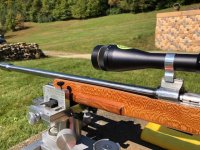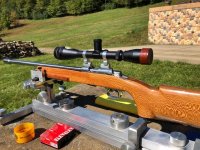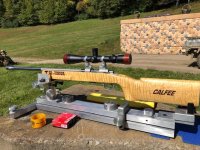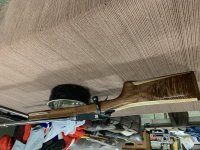tonykharper
Well-known member
IR 50/50 Sporters History
Rimfire Benchrest IR 50/50 Sporters
The IR 50/50 sporter class is the most difficult of all the classes in IR 50/50, barring the new Sporter 10 shot.
Shooting IR 50/50 sporter class was born when Milt Cook started IR 50/50. He more or less adopted the centerfire program. Over time changes have been made to the class.
In my opinion the term “sporter” means “a sporting weapon” as in a weapon that could be safely carried into the woods to hunt. The 7.5 lb weight limit is reasonable,
as is the need for a clip, 6.5 power scope, and a safety. When they changed the rule to get rid of the safety they went against this principle in the interest of saving
money for safety equipped triggers. A poor reason and a mistake in my opinion.
What we have now is an ultra light custom class not a true Sporter class but that is water under the bridge.
Whatever we call it there is no doubt the Sporter Class (I’ll call it that) rifle is the most evolved rifle we shoot today. In my opinion it is also the most fun to shoot.
The large black lines on the IR 50/50 target were designed to be seen with a 6.5 power scope and in most cases they are only lines you can see.
When shooting a target, and the flags are telling you there is a bullet of push, and a half bullet of lift, and you hold your dot just a little to one side of center circle, and a little low and
touch off the trigger, then look through the spotting scope and see you cut the X dot out, it is like a gift from God. You couldn’t even see that dot but yet
you cut it out. It is a much greater thrill than shooting an X with a heavy gun with a high power scope.
In the early days when we shot factory sporters, even the souped up ones would shoot on the average 240 - 242 targets, some would do better, but not many.
Then something very interesting happened.
Bill Calfee made the first muzzle device equipped sporter barrel from a Douglas #1 barrel blank.
A #1 Douglas blank has an enlarged big end of 1.150" for three inches, then tapers to a muzzle diameter of .625". He turned this #1 Douglas rimfire blank around backwards,
using the enlarged breech end for the muzzle device, then shrunk some 1.150" round stock to the .625" diameter muzzle end, giving enough metal to thread and shoulder it to a
54 Anschutz sporter action.
Then Bill finished profiling this backwards #1 Douglas blank so it would include a muzzle device and make weight for a 7-1/2 lb sporter rifle.
He then taper lapped the blank, chambered it, and worked out the depth, and diameter of the counterbore for the muzzle device.
When you think of it this was quite an undertaking.
No other gunsmith had ever, or would ever, take on such a task. This entire process took about a year to complete.
Harry Deneen presented this first ever, IR-50/50 Sporter rifle with its two piece, muzzle device equipped barrel, to his good friend Milt Cook for IR 50/50 approval.
Milt had the foresight to see this would help the class, and make sporters much more accurate and competitive than ever before. He approved the barrel, even making
exception in the IR-50/50 Sporter class rules for the barrel being two piece. Milt indeed made a great decision. Had he went the other way, we would still be shooting for 240’s and 242’s.
Harry Deneen killed the world with this sporter until he finally wore the barrel out proving this was indeed a better mouse trap.
Barrel makers of the world took note of Harry’s success and immediately started copying this muzzle device equipped, Sporter profile barrel .
Of course, they were able to make them one piece.
Nearly every sporter today in IR 50/50 has this same barrel profile. Actually, there are two profiles,
the original tapered one, and the newer stepped one. Both seem to work equally as well.
The next advancement came when Gentleman Jim Pepper, and Greg Davis contacted Flash Ebert to ask him to make a sporter version of the Rimfire Turbo action.
Again this took time, but Flash decided why not, and made the first two. He first started with an aluminum action then went to the steel one we see today.
Calfee looked at the actions and decided with the large clip cut out, it would not allow the stock to be bedded properly.
Then along came Bill Pippin, he looked at the actions and said he would make a stab at it. Bill Pippin proceeded to make the very best benchrest sporter stock profile ever developed.
Many of those first ones have been around for nearly a decade, and have never been rebedded, they are still winning today.
To say Bill Pippin was successful is an understatement. His stocks are highly sought after. We lost a lot when we lost Bill.
At this point we had a barrel profile that incorporated a muzzle device, a high quality PAS equipped action light enough for a 7.5 lb rifle, and a great sporter stock to bed that action in.
Enter Gordon Eck. The gunsmith from New York. He used these components to build the very best IR 50/50 legal sporters in the world.
This was proved very quickly. Greg Davis won the World 50 meter Sporter Class in South Carolina in 2009, I won the 25 meter sporter class,
and I can’t count the number of National matches that these Eck sporters have won.
When I ordered my Eck sporter, Gordon asked me “how many 250s have you shot with a sporter” I told him NONE. He told me get ready to.
I thought he was bragging but it ain’t bragging when you can back it up and he backed it up in spades.
Eck sporters made shooting 250s fairly routine. Don’t get me wrong shooting a 250 with a 7.5 lb rifle, with a 6.5X scope isn’t easy, but for those capable the rifle will get it done.
Many shooters think their Eck sporter out shoots their heavy rifles. With the Pippin stock these sporters handled like a heavy gun although they met all of the IR 50/50 requirements.
These Eck sporters are still winning.
To be fair, other gunsmiths have built excellent sporters. Kent Owens built sporters for Ken Camper and Bruce Hornstein. These guys have won about everything there is win with them.
Then, there is Dexter Bumgardner, his sporter’s are as good as they come. Look at what Barry Harris has done with his.
Bill Calfee’s sporters are legendary. Probably the most valuable sporter in the world today is the sporter Calfee built for DJ Hepler. It is a one off.
This was the very first steel Turbo sporter ever made. It was serial number #0013 like all other DJ serial numbers. I think Craig Young owns that rifle today.
With all that said, it would take more than a pretty penny to get TD Junior.
There are many differences between Hepler’s sporter and TD Junior, TD Junior has been copied by other smith’s and some of these copies are pretty darn good.
Nobody has ever copied Hepler’s and probably never will.
I’m sure other smiths have built great sporters and I don’t want to slight them in anyway, but I’m just not aware of them.
My hope is others will read this post and be able to add to the story.
It should be clear, I love shooting Sporters, and I believe others do as well. I don’t want the history of its development to be lost or forgotten.
TKH
https://imgur.com/a/I6ckqVI
Rimfire Benchrest IR 50/50 Sporters
The IR 50/50 sporter class is the most difficult of all the classes in IR 50/50, barring the new Sporter 10 shot.
Shooting IR 50/50 sporter class was born when Milt Cook started IR 50/50. He more or less adopted the centerfire program. Over time changes have been made to the class.
In my opinion the term “sporter” means “a sporting weapon” as in a weapon that could be safely carried into the woods to hunt. The 7.5 lb weight limit is reasonable,
as is the need for a clip, 6.5 power scope, and a safety. When they changed the rule to get rid of the safety they went against this principle in the interest of saving
money for safety equipped triggers. A poor reason and a mistake in my opinion.
What we have now is an ultra light custom class not a true Sporter class but that is water under the bridge.
Whatever we call it there is no doubt the Sporter Class (I’ll call it that) rifle is the most evolved rifle we shoot today. In my opinion it is also the most fun to shoot.
The large black lines on the IR 50/50 target were designed to be seen with a 6.5 power scope and in most cases they are only lines you can see.
When shooting a target, and the flags are telling you there is a bullet of push, and a half bullet of lift, and you hold your dot just a little to one side of center circle, and a little low and
touch off the trigger, then look through the spotting scope and see you cut the X dot out, it is like a gift from God. You couldn’t even see that dot but yet
you cut it out. It is a much greater thrill than shooting an X with a heavy gun with a high power scope.
In the early days when we shot factory sporters, even the souped up ones would shoot on the average 240 - 242 targets, some would do better, but not many.
Then something very interesting happened.
Bill Calfee made the first muzzle device equipped sporter barrel from a Douglas #1 barrel blank.
A #1 Douglas blank has an enlarged big end of 1.150" for three inches, then tapers to a muzzle diameter of .625". He turned this #1 Douglas rimfire blank around backwards,
using the enlarged breech end for the muzzle device, then shrunk some 1.150" round stock to the .625" diameter muzzle end, giving enough metal to thread and shoulder it to a
54 Anschutz sporter action.
Then Bill finished profiling this backwards #1 Douglas blank so it would include a muzzle device and make weight for a 7-1/2 lb sporter rifle.
He then taper lapped the blank, chambered it, and worked out the depth, and diameter of the counterbore for the muzzle device.
When you think of it this was quite an undertaking.
No other gunsmith had ever, or would ever, take on such a task. This entire process took about a year to complete.
Harry Deneen presented this first ever, IR-50/50 Sporter rifle with its two piece, muzzle device equipped barrel, to his good friend Milt Cook for IR 50/50 approval.
Milt had the foresight to see this would help the class, and make sporters much more accurate and competitive than ever before. He approved the barrel, even making
exception in the IR-50/50 Sporter class rules for the barrel being two piece. Milt indeed made a great decision. Had he went the other way, we would still be shooting for 240’s and 242’s.
Harry Deneen killed the world with this sporter until he finally wore the barrel out proving this was indeed a better mouse trap.
Barrel makers of the world took note of Harry’s success and immediately started copying this muzzle device equipped, Sporter profile barrel .
Of course, they were able to make them one piece.
Nearly every sporter today in IR 50/50 has this same barrel profile. Actually, there are two profiles,
the original tapered one, and the newer stepped one. Both seem to work equally as well.
The next advancement came when Gentleman Jim Pepper, and Greg Davis contacted Flash Ebert to ask him to make a sporter version of the Rimfire Turbo action.
Again this took time, but Flash decided why not, and made the first two. He first started with an aluminum action then went to the steel one we see today.
Calfee looked at the actions and decided with the large clip cut out, it would not allow the stock to be bedded properly.
Then along came Bill Pippin, he looked at the actions and said he would make a stab at it. Bill Pippin proceeded to make the very best benchrest sporter stock profile ever developed.
Many of those first ones have been around for nearly a decade, and have never been rebedded, they are still winning today.
To say Bill Pippin was successful is an understatement. His stocks are highly sought after. We lost a lot when we lost Bill.
At this point we had a barrel profile that incorporated a muzzle device, a high quality PAS equipped action light enough for a 7.5 lb rifle, and a great sporter stock to bed that action in.
Enter Gordon Eck. The gunsmith from New York. He used these components to build the very best IR 50/50 legal sporters in the world.
This was proved very quickly. Greg Davis won the World 50 meter Sporter Class in South Carolina in 2009, I won the 25 meter sporter class,
and I can’t count the number of National matches that these Eck sporters have won.
When I ordered my Eck sporter, Gordon asked me “how many 250s have you shot with a sporter” I told him NONE. He told me get ready to.
I thought he was bragging but it ain’t bragging when you can back it up and he backed it up in spades.
Eck sporters made shooting 250s fairly routine. Don’t get me wrong shooting a 250 with a 7.5 lb rifle, with a 6.5X scope isn’t easy, but for those capable the rifle will get it done.
Many shooters think their Eck sporter out shoots their heavy rifles. With the Pippin stock these sporters handled like a heavy gun although they met all of the IR 50/50 requirements.
These Eck sporters are still winning.
To be fair, other gunsmiths have built excellent sporters. Kent Owens built sporters for Ken Camper and Bruce Hornstein. These guys have won about everything there is win with them.
Then, there is Dexter Bumgardner, his sporter’s are as good as they come. Look at what Barry Harris has done with his.
Bill Calfee’s sporters are legendary. Probably the most valuable sporter in the world today is the sporter Calfee built for DJ Hepler. It is a one off.
This was the very first steel Turbo sporter ever made. It was serial number #0013 like all other DJ serial numbers. I think Craig Young owns that rifle today.
With all that said, it would take more than a pretty penny to get TD Junior.
There are many differences between Hepler’s sporter and TD Junior, TD Junior has been copied by other smith’s and some of these copies are pretty darn good.
Nobody has ever copied Hepler’s and probably never will.
I’m sure other smiths have built great sporters and I don’t want to slight them in anyway, but I’m just not aware of them.
My hope is others will read this post and be able to add to the story.
It should be clear, I love shooting Sporters, and I believe others do as well. I don’t want the history of its development to be lost or forgotten.
TKH
https://imgur.com/a/I6ckqVI
Attachments
Last edited:








